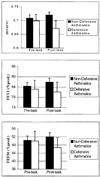Defensiveness and individual response stereotypy in asthma
- PMID: 11914446
- PMCID: PMC2958692
- DOI: 10.1097/00006842-200203000-00013
Defensiveness and individual response stereotypy in asthma
Abstract
Objective: Previous literature has shown that the psychological trait of defensiveness is related to elevated sympathetic reactivity to stress and to several cardiac risk factors. The aim of this study was to examine whether these previous findings on defensiveness extend to an asthmatic population.
Methods: Defensiveness was measured by the Marlowe-Crowne Social Desirability Scale using a quartile split: high (upper 25%) and low (bottom 75%). Twenty-two defensive and 66 nondefensive participants with asthma were exposed to laboratory tasks (initial baseline rest period, reaction time task, and a shop accident film).
Results: During the tasks there was evidence of lower skin conductance levels and greater respiratory sinus arrhythmia amplitudes among defensive patients with asthma. After exposure to the tasks, defensive patients with asthma showed a decline on spirometry test measures compared with nondefensive asthmatic patients, who displayed an increase.
Conclusions: These data confirm individual response stereotypy and suggest that defensiveness may be characterized by sympathetic hypoarousal and parasympathetic hyperarousal among patients with asthma. Future studies are needed to determine whether defensiveness is a risk factor for stress-induced bronchoconstriction.
Figures
References
-
- Lacey JI, Lacey BC. Verification and extension of the principle of response-stereotypy. Am J Psychol. 1958;71:50–73. - PubMed
-
- Miller SB, Ditto B. Exaggerated sympathetic nervous system response to extended psychological stress in offspring of hypertensives. Psychophysiology. 1991;28:103–113. - PubMed
-
- Ritz T, Steptoe A, DeWilde S, Costa M. Emotions and stress increase respiratory resistance in asthma. Psychosom Med. 2000;62:401–412. - PubMed
-
- Miller BD, Wood BL. Psychophysiologic reactivity in asthmatic children: a cholinergically mediated confluence of pathways. J Am Acad Child Adolesc Psychiatry. 1994;33:1236–1245. - PubMed
-
- Levenson R. Effects of thematically relevant and general stressors on specificity of responding in asthmatic and nonasthmatic subjects. Psychosom Med. 1979;41:28–39. - PubMed


